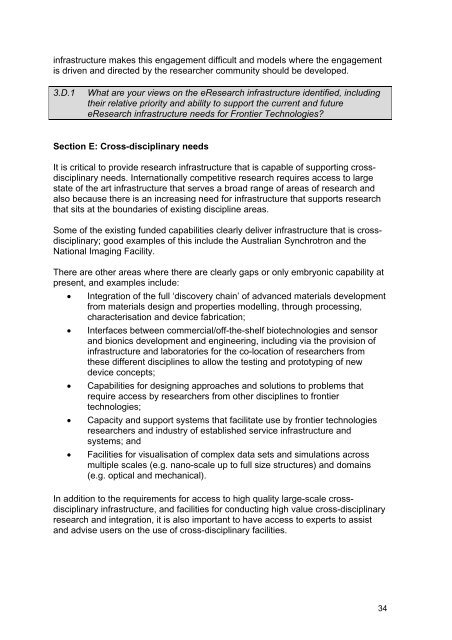2011 Strategic Roadmap for Australian Research Infrastructure
2011 Strategic Roadmap for Australian Research Infrastructure
2011 Strategic Roadmap for Australian Research Infrastructure
You also want an ePaper? Increase the reach of your titles
YUMPU automatically turns print PDFs into web optimized ePapers that Google loves.
infrastructure makes this engagement difficult and models where the engagement<br />
is driven and directed by the researcher community should be developed.<br />
3.D.1<br />
What are your views on the e<strong>Research</strong> infrastructure identified, including<br />
their relative priority and ability to support the current and future<br />
e<strong>Research</strong> infrastructure needs <strong>for</strong> Frontier Technologies?<br />
Section E: Cross-disciplinary needs<br />
It is critical to provide research infrastructure that is capable of supporting crossdisciplinary<br />
needs. Internationally competitive research requires access to large<br />
state of the art infrastructure that serves a broad range of areas of research and<br />
also because there is an increasing need <strong>for</strong> infrastructure that supports research<br />
that sits at the boundaries of existing discipline areas.<br />
Some of the existing funded capabilities clearly deliver infrastructure that is crossdisciplinary;<br />
good examples of this include the <strong>Australian</strong> Synchrotron and the<br />
National Imaging Facility.<br />
There are other areas where there are clearly gaps or only embryonic capability at<br />
present, and examples include:<br />
Integration of the full ‘discovery chain’ of advanced materials development<br />
from materials design and properties modelling, through processing,<br />
characterisation and device fabrication;<br />
Interfaces between commercial/off-the-shelf biotechnologies and sensor<br />
and bionics development and engineering, including via the provision of<br />
infrastructure and laboratories <strong>for</strong> the co-location of researchers from<br />
these different disciplines to allow the testing and prototyping of new<br />
device concepts;<br />
Capabilities <strong>for</strong> designing approaches and solutions to problems that<br />
require access by researchers from other disciplines to frontier<br />
technologies;<br />
Capacity and support systems that facilitate use by frontier technologies<br />
researchers and industry of established service infrastructure and<br />
systems; and<br />
Facilities <strong>for</strong> visualisation of complex data sets and simulations across<br />
multiple scales (e.g. nano-scale up to full size structures) and domains<br />
(e.g. optical and mechanical).<br />
In addition to the requirements <strong>for</strong> access to high quality large-scale crossdisciplinary<br />
infrastructure, and facilities <strong>for</strong> conducting high value cross-disciplinary<br />
research and integration, it is also important to have access to experts to assist<br />
and advise users on the use of cross-disciplinary facilities.<br />
34
















